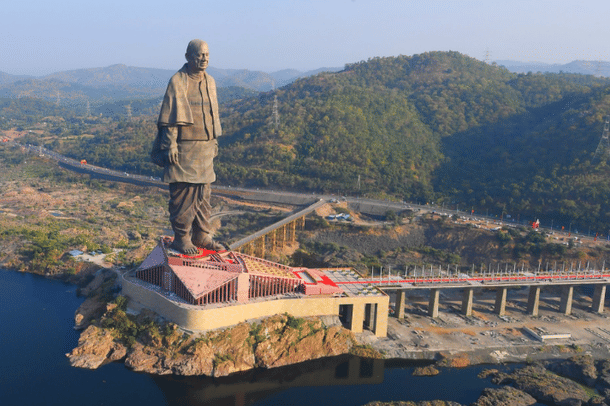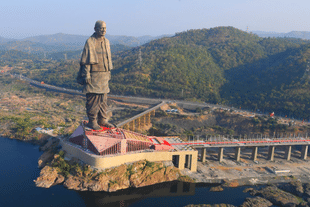Ideas
What Sardar Statue, The World’s Tallest, Tells Us: Modi Has Taught Nation To Think Audaciously Big
R Jagannathan
Oct 31, 2018, 12:02 PM | Updated 12:02 PM IST
Save & read from anywhere!
Bookmark stories for easy access on any device or the Swarajya app.


The usual carping by opposition parties over anything the Narendra Modi government does, does not take anything away from the gigantic engineering achievement that the 182-metre Sardar Vallabhbhai Patel statue in Gujarat embodies. Nearly twice as tall as New York’s Statue of Liberty, the statue, inaugurated today (31 October) by the Prime Minister, is something for the nation to be proud of. And what matters is not the statue itself, but the shift in the nation’s mindset it represents.
As the world’s tallest statue, which consumed over 2 lakh cubic metres of cement concrete, 25,000 tonnes of structural and reinforcement steel, and 1,700 tonnes of bronze cladding, the statue was designed and completed in a record time of 46 months – something few Indian projects can ever claim. If we had only brought this kind of fervour and implementation zeal to some of our other mission-critical projects, India would have been a standout performer on the global league.
If, instead, we have seen only negativity on various sides, whether from the opposition or the anti-Modi media or even historians, it means we are a nation of compulsive quibblers. And quibblers can never achieve greatness. Hopefully, the statue which Modi got built will make us a nation of fewer quibblers.
The statue is being criticised for using Chinese material and some labour; Congress politicians have complained bitterly about Modi trying to appropriate Congress icons like Sardar and Netaji Bose; the anti-Modi media is busy explaining how Patel was against the RSS, and historian Ramachandra Guha has been trying hard to prove that Nehru and Patel were colleagues, not rivals, as if that explains why the Congress never gave him his due till Modi came to claim him as his own inspiration. The point is, when you studiously avoid giving other tall leaders their due, why would a Modi not seek to appropriate them for his purposes?
As if that were not enough, questions are being raised about whether the nearly Rs 3,000 crore spent on building the Statue of Unity could not have been spent better elsewhere. But then this can be asked about almost any expenditure of a significant size. We can ask how many hungry people can be fed for the price of a Rafale fighter; we can (and have) asked whether our enormous spending on cricket is right when so many schools have no playgrounds. If India today is a powerhouse in cricket, it is because we did not get unduly discouraged by this kind of discourse.
To be sure, there are genuine criticisms by the people affected in the areas cleared for the statue, including the environmental impact of the project. But these criticisms are minuscule.
What is not being asked is whether a huge tourist draw like the Sardar statue, which is located on Sadhu Bet Island near the Sardar Sarovar Dam, and where people can take the lift upto 153 metres and view the world from the Sardar’s bronze chest, will not rejuvenate tourism in this part of the state. As a state with far fewer scenic tourist attractions than many others located near hills or waterfalls, the Sardar statue is a useful manmade wonder for people to ooh-and-aah over.
Similar questions will – and are being asked – by people about the proposed Shivaji statue off the southern tip of Mumbai, which too will bring huge tourist dollars. Once again, the Maharashtra government needs to ignore them. The critics are wrong.
What Modi has demonstrated with the Sardar statue is something more fundamental: that Indians can dream big, think big, and execute big whenever there is political will. In fact, thinking big has been the hallmark of the Modi government, whether it is the rapid expansion of Jan Dhan banking to all households, universalising the unique ID scheme and direct benefits transfers, extending toilets to all homes, promising homes for all by 2022, or rolling out free medical insurance to 50 crore people.
Even if some of these schemes fall far short of expectations, Modi will still have shown that India can grow out of the habit of thinking small, where we prefer to wallow in limiting the potential of our people by placing artificial restraints on their growth and imaginations. This was the India of Nehru and Indira Gandhi, who forced our world-beating entrepreneurs to run with a lead ball attached to their feet, and who reduced everyday living to a hurdle race for the poor, whether it was for obtaining meagre rations or medical help. We made people run for basics, but never encouraged them to run for achieving something truly unique.
It is nobody’s case that Modi has done well on all fronts, but nobody can fault him either for breaking the mould of thinking small. The Sardar statue is a physical reminder of this new Indian spirit that is unwilling to let the sky be the limit. It represents a mind-shift that goes far beyond just the costs-and-benefits related to one gigantic statue.
Before Modi, we were a nation of quibblers. After Modi, we will still be substantially so, as the critiques of the statue show. But many Indians are willing to ignore this quibbling and move on and excel. That is something worth achieving.
Management writers Jim Collins and Jerry Porras, in their path-breaking 1994 book, Built To Last: Successful Habits of Visionary Companies, noted that successful leaders often set Big, Hairy Audacious Goals (BHAGs) to motivate their staff to greater heights of performance. This is exactly what Modi has done. The Sardar statue is a demonstration of BHAG at work. The licence-permit raj was the work of small minds; the Sardar statue - despite its political underpinnings - is the work of an expansive mind.
Jagannathan is former Editorial Director, Swarajya. He tweets at @TheJaggi.




